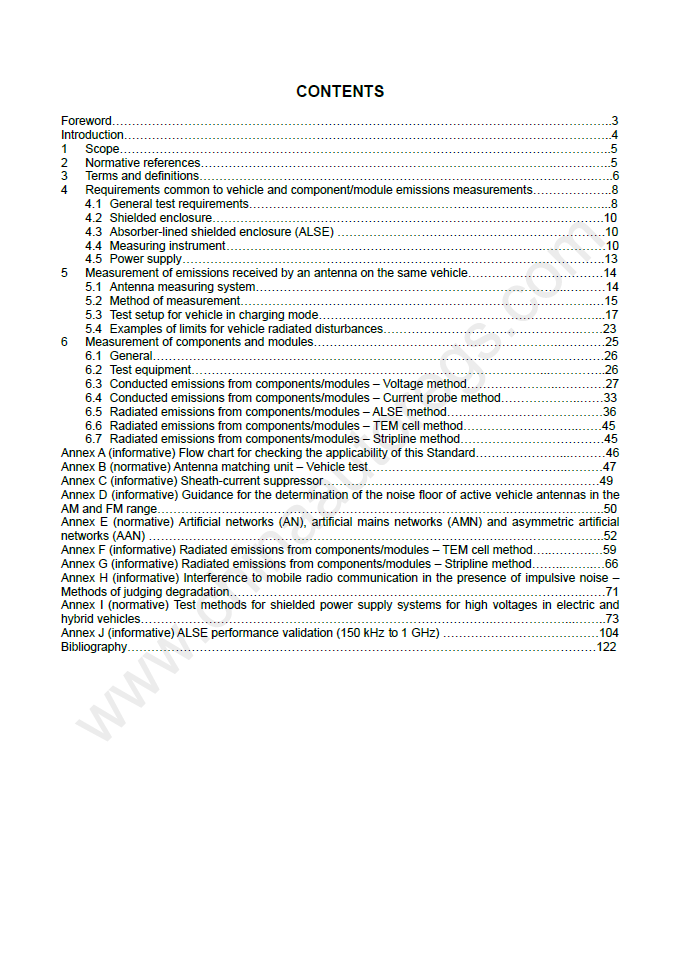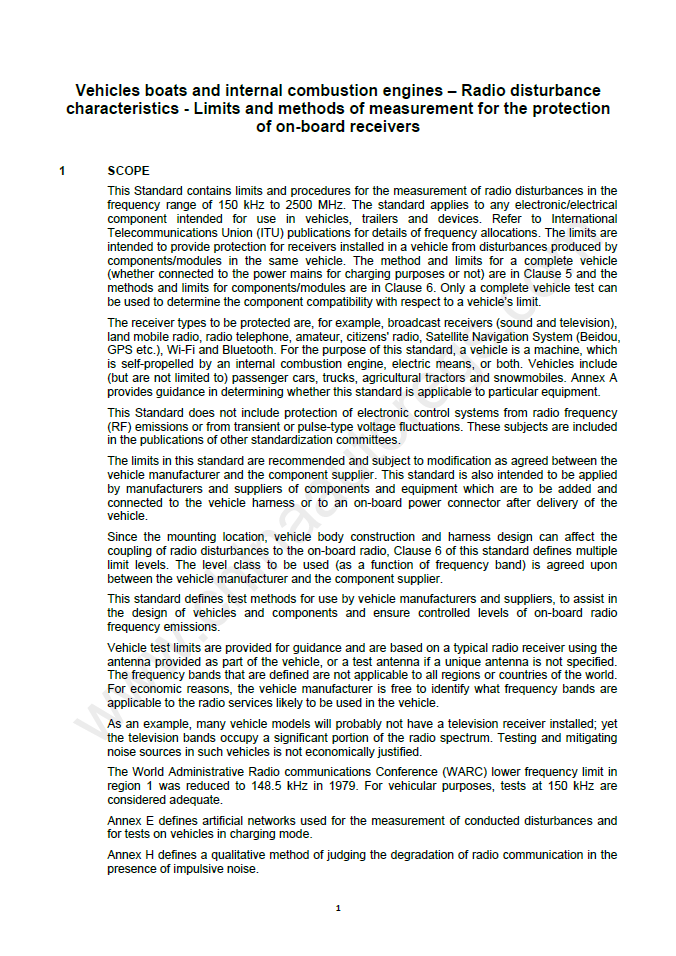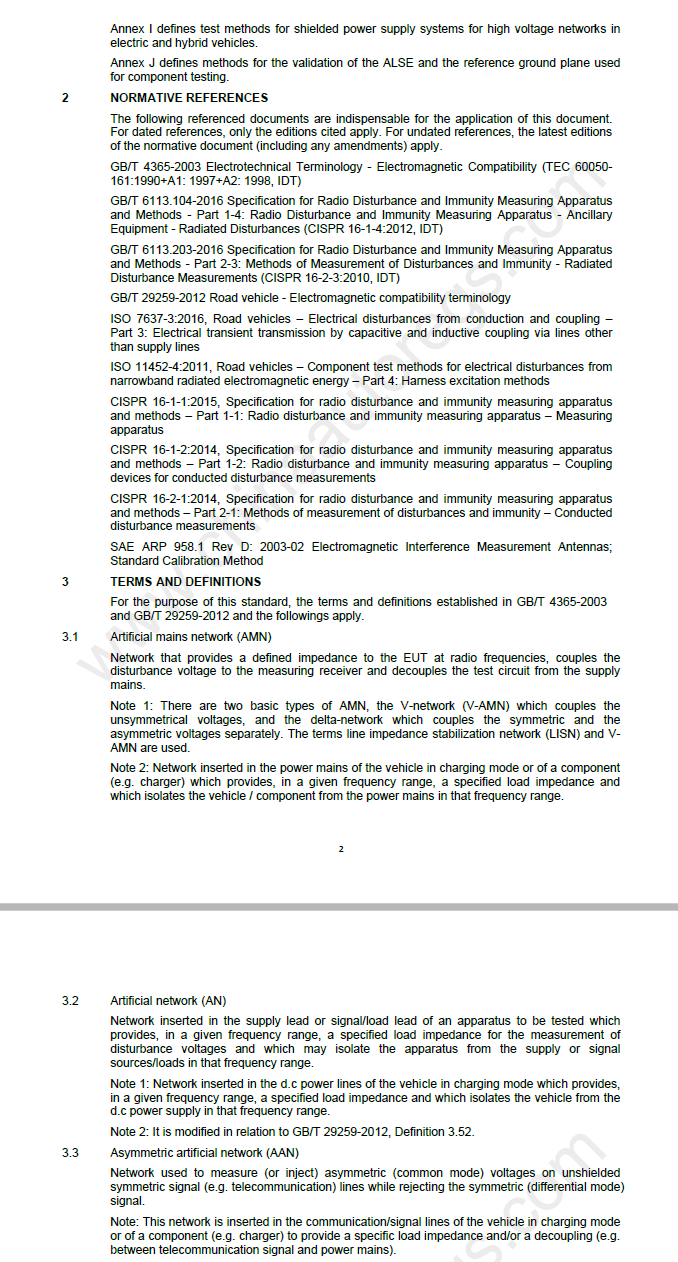ChinaAutoRegs|GB/T 18655-2018 英文版/English/翻译/车辆、船和内燃机 无线电骚扰特性 用于保护车载接收机的限值和测量方法
Vehicles, Boats and Internal Combustion Engines – Radio Disturbance Characteristics – Limits and Methods of Measurement for the Protection of On-Board Receivers
CONTENTS
Foreword
Introduction
1 Scope
2 Normative references…
3 Terms and definitions
4 Requirements common to vehicle and component/module emissions measurements
5 Measurement of emissions received by an antenna on the same vehicle
6 Measurement of components and modules
Annex A (informative) Flow chart for checking the applicability of this Standard
Annex B (normative) Antenna matching unit – Vehicle test
Annex C (informative) Sheath-current suppressor
Annex D (informative) Guidance for the determination of the noise floor of active vehicle antennas in the AM and FM range
Annex E (normative) Artificial networks (AN), artificial mains networks (AMN) and asymmetric artificial networks (AAN)
Annex F (informative) Radiated emissions from components/modules – TEM cell method
Annex G (informative) Radiated emissions from components/modules – Stripline method
Annex H (informative) Interference to mobile radio communication in the presence of impulsive noise – Methods of judging degradation
Annex I (normative) Test methods for shielded power supply systems for high voltages in electric and hybrid vehicles
Annex J (informative) ALSE performance validation (150 kHz to 1 GHz)
Bibliography
1 SCOPE
This Standard contains limits and procedures for the measurement of radio disturbances in the frequency range of 150 kHz to 2500 MHz. The standard applies to any electronic/electrical component intended for use in vehicles, trailers and devices. Refer to International Telecommunications Union (ITU) publications for details of frequency allocations. The limits are intended to provide protection for receivers installed in a vehicle from disturbances produced by components/modules in the same vehicle. The method and limits for a complete vehicle (whether connected to the power mains for charging purposes or not) are in Clause 5 and the methods and limits for components/modules are in Clause 6. Only a complete vehicle test can be used to determine the component compatibility with respect to a vehicle’s limit.
The receiver types to be protected are, for example, broadcast receivers (sound and television), land mobile radio, radio telephone, amateur, citizens’ radio, Satellite Navigation System (Beidou, GPS etc.), Wi-Fi and Bluetooth. For the purpose of this standard, a vehicle is a machine, which is self-propelled by an internal combustion engine, electric means, or both. Vehicles include (but are not limited to) passenger cars, trucks, agricultural tractors and snowmobiles. Annex A provides guidance in determining whether this standard is applicable to particular equipment.
This Standard does not include protection of electronic control systems from radio frequency (RF) emissions or from transient or pulse-type voltage fluctuations. These subjects are included in the publications of other standardization committees.
The limits in this standard are recommended and subject to modification as agreed between the vehicle manufacturer and the component supplier. This standard is also intended to be applied by manufacturers and suppliers of components and equipment which are to be added and connected to the vehicle harness or to an on-board power connector after delivery of the vehicle.
XXXX
2 NORMATIVE REFERENCES
The following referenced documents are indispensable for the application of this document. For dated references, only the editions cited apply. For undated references, the latest editions of the normative document (including any amendments) apply.
GB/T 4365-2003 Electrotechnical Terminology – Electromagnetic Compatibility (TEC 60050-161:1990+A1: 1997+A2: 1998, IDT)
GB/T 6113.104-2016 Specification for Radio Disturbance and Immunity Measuring Apparatus and Methods – Part 1-4: Radio Disturbance and Immunity Measuring Apparatus – Ancillary Equipment – Radiated Disturbances (CISPR 16-1-4:2012, IDT)
GB/T 6113.203-2016 Specification for Radio Disturbance and Immunity Measuring Apparatus and Methods – Part 2-3: Methods of Measurement of Disturbances and Immunity – Radiated Disturbance Measurements (CISPR 16-2-3:2010, IDT)
GB/T 29259-2012 Road vehicle – Electromagnetic compatibility terminology
ISO 7637-3:2016, Road vehicles – Electrical disturbances from conduction and coupling – Part 3: Electrical transient transmission by capacitive and inductive coupling via lines other than supply lines
ISO 11452-4:2011, Road vehicles – Component test methods for electrical disturbances from narrowband radiated electromagnetic energy – Part 4: Harness excitation methods
CISPR 16-1-1:2015, Specification for radio disturbance and immunity measuring apparatus and methods – Part 1-1: Radio disturbance and immunity measuring apparatus – Measuring apparatus
CISPR 16-1-2:2014, Specification for radio disturbance and immunity measuring apparatus and methods – Part 1-2: Radio disturbance and immunity measuring apparatus – Coupling devices for conducted disturbance measurements
CISPR 16-2-1:2014, Specification for radio disturbance and immunity measuring apparatus and methods – Part 2-1: Methods of measurement of disturbances and immunity – Conducted disturbance measurements
SAE ARP 958.1 Rev D: 2003-02 Electromagnetic Interference Measurement Antennas; Standard Calibration Method
3 TERMS AND DEFINITIONS
For the purpose of this standard, the terms and definitions established in GB/T 4365-2003 and GB/T 29259-2012 and the followings apply.
3.1
Artificial mains network (AMN)
Network that provides a defined impedance to the EUT at radio frequencies, couples the disturbance voltage to the measuring receiver and decouples the test circuit from the supply mains.
Note 1: There are two basic types of AMN, the V-network (V-AMN) which couples the unsymmetrical voltages, and the delta-network which couples the symmetric and the asymmetric voltages separately. The terms line impedance stabilization network (LISN) and V-AMN are used.
Note 2: Network inserted in the power mains of the vehicle in charging mode or of a component (e.g. charger) which provides, in a given frequency range, a specified load impedance and which isolates the vehicle / component from the power mains in that frequency range.
3.2
Artificial network (AN)
Network inserted in the supply lead or signal/load lead of an apparatus to be tested which provides, in a given frequency range, a specified load impedance for the measurement of disturbance voltages and which may isolate the apparatus from the supply or signal sources/loads in that frequency range.
Note 1: Network inserted in the d.c power lines of the vehicle in charging mode which provides, in a given frequency range, a specified load impedance and which isolates the vehicle from the d.c power supply in that frequency range.
Note 2: It is modified in relation to GB/T 29259-2012, Definition 3.52.
3.3
Asymmetric artificial network (AAN)
Network used to measure (or inject) asymmetric (common mode) voltages on unshielded symmetric signal (e.g. telecommunication) lines while rejecting the symmetric (differential mode) signal.
Note: This network is inserted in the communication/signal lines of the vehicle in charging mode or of a component (e.g. charger) to provide a specific load impedance and/or a decoupling (e.g. between telecommunication signal and power mains).
3.4
Bandwidth (of an equipment)
Width of a frequency band over which a given characteristic of an equipment or transmission channel does not differ from its reference value by more than a specified amount or ratio.
Note 1: The given characteristic may be the amplitude/frequency characteristic, the phase/frequency characteristic or the delay/frequency characteristic.
Note 2: It is modified in relation to GB/T 4365-2003, Definition 161-06-09.
3.5
Bonded (ground connection and d.c. resistance)
Grounding connection with a DC resistance not exceeding 2.5 m and that provides the lowest possible impedance (resistance and inductance) connection between two metallic parts.
Note: A low current (100 mA) 4-wire milliohm meter is recommended for these measurements.
3.6
Class
Performance level agreed upon by the purchaser and the supplier and documented in the test plan.
3.7
Device
Machine driven by an internal combustion engine which is not primarily intended to carry persons or goods.
Note: Devices include, but are not limited to, chainsaws, irrigation pumps, snow blowers, air compressors, and landscaping equipment.
3.8
High voltage HV
Operating voltage between 60 V to 1000 V.
Note: The term high voltage may be defined with a different voltage range in other standards.
1、现成译文,到款即发。
2、下单前可任取样页验证译文质量。
3、免费提供正规普通增值税数电发票。
4、请联系手机/微信: 13306496964/Email: standardtrans@foxmail.com 获取完整译文。
5、本英文译本为纯人工专业精翻版本,保证语法术语准确率和专业度!
6、专业源于专注|ChinaAutoRegs 始终专注于汽车标准翻译领域!
7、「中国汽车标准译文库」已收录上千个现行汽车国家标准和行业标准的英文版译本,涵盖传统燃油车、新能源汽车和摩托车标准化体系!独家打造千万级汽车专业术语库和记忆库。
1. The English Translation of this document is readily available, and delivered immediately upon payment.
2. You may request for sample pages to your preference before placing an order.
3. Please contact standardtrans@foxmail.com for the complete PDF version in English.
4. Almost all of Chinese automotive/automobile standards, regulations and norms (GB, GB/T, QC/T, CNCA, CQC, CAV, etc.) in effect have been included in our well-established database, providing one-stop, up-to-date, efficient and professional solution.




